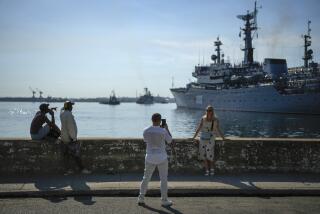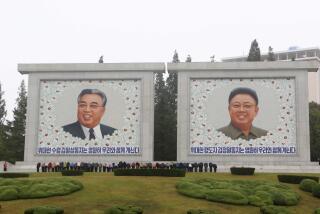Most Weapons Bolster Forces There, Some Go to Contras : Arms Ships Stop Frequently in Honduras
- Share via
PUERTO CORTES, Honduras — At the rate of at least one a month, ships from all over the world land at this steamy port on the Caribbean coast to unload cargoes of arms.
Much of the weaponry is bound for the Honduran military, which has been slowly building up to match the growth of the armies in neighboring Nicaragua and El Salvador. But some of it is destined for the contras-- the rebels operating in this country whose avowed intent is to topple the Marxist government in Nicaragua.
Of all the government and commercial ships that have borne arms here in the past two years, one is attracting particular attraction. It is the Erria, a 299-ton freighter that was flying under the Danish flag when it stopped here on June 2, 1985.
Soviet-Bloc Weapon
Contra leaders said Friday that the Erria’s cargo included 5,000 AK-47s, the standard Soviet-Bloc infantry weapon. The Honduran army does not use AK-47s. The contras do.
The contra officials said the AK-47s aboard the Erria had been bought from the Polish government by a foreign arms dealer acting on the rebels’ behalf.
Poland’s Communist government, like other Soviet-Bloc nations, officially opposes the contras. But Adolfo Calero, the leader of the largest contra faction, has said: “We often buy arms from the Soviet Bloc, although they may not know it. They are selling us the guns to fight communism.”
No records have surfaced to show who was leasing the Erria in June of 1985. But 10 months later, the freighter was purchased by a Panamanian company whose forwarding address is that of a Geneva firm intimately linked to the U.S. government’s sale of arms to Iran.
Ransom for Hostages
And a month after its sale, the Erria was off the coast of Cyprus carrying $1 million that U.S. officials had hoped would help buy the freedom of American hostages then held in nearby Lebanon. On that very day, Lt. Col. Oliver L. North, the White House aide who oversaw both the Administration’s efforts to win private support for the contras and its secret arms sales to Iran, arrived in Iran with a planeload of weapons to bargain for the hostages’ release.
Port records here tell little about the Erria’s visit in June of 1985 other than to list the ship’s navigational agent as Will Nielsen.
“When a ship comes in with arms, there’s no paper work,” said a Honduran government official. “You will never see paper saying they brought arms.”
Kept secret from the public is a book with coded entries showing which ships carried arms. That book, an official said, showed a variety of arms-bearing ships that had docked at Puerto Cortes in 1985 and 1986--including the Erria.
Three U.S. Vessels
Three were apparently U.S. commercial ships. The Powell 114 arrived on Feb. 22, 1986, the Mydas docked on Sept. 3, and the Cape Douglas came on Dec. 16. It was unclear what kinds of arms they bore. Their cargo was listed as being bound for the Honduran armed forces, but a port source said arms for the contras typically go through the Honduran military.
Besides the Erria, two other Danish ships appeared on the encoded list of arms deliverers. So did a Greek ship. Besides these, U.S. military ships made at least 21 arms deliveries in this period.
What is more, the Honduran official said, some ships dock here and never appear on the public ship registry. In this category he put the Gen. William J. Sutton, a U.S. government ship that he said was in the Caribbean for maneuvers last summer and, according to the coded list, delivered arms.
More to Read
Sign up for Essential California
The most important California stories and recommendations in your inbox every morning.
You may occasionally receive promotional content from the Los Angeles Times.













